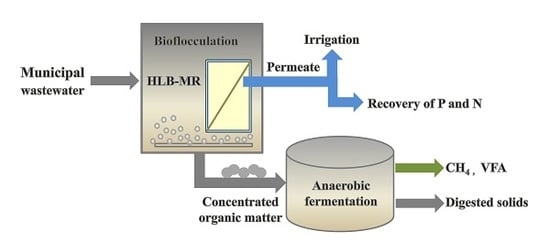High-Loaded Bioflocculation Membrane Reactor of Novel Structure for Organic Matter Recovery from Sewage: Effect of Dissolved Oxygen on Bioflocculation and Membrane Fouling
Abstract
1. Introduction
2. Materials and Methods
2.1. Experimental Setup and Operation Parameters
2.2. Samples and Analysis
3. Results and Discussion
3.1. Concentration and Recovery of Organic Matter
3.2. Bioflocculation
3.3. EPS and Metal Cation Concentration
3.4. Analysis of Membrane Fouling
3.5. Structural Characteristics of the Microbial Community
4. Conclusions
- (1)
- The recovery efficiency of organic matter in the LDO reactor was 70.2%; lower than the 77.5% when the HDO reactor Nonetheless, the fractions of CODss in the concentrate of the two reactors were not significantly different, and both of them exceeded 94%;
- (2)
- The flocculation efficiency of the LDO reactor and the HDO reactor was 83% and 89%, respectively. A higher DO concentration promised a more remarkable bioflocculation performance;
- (3)
- The contents of both bound and free EPS in the HDO reactor were significantly higher than those under the LDO reactor. A similar trend was observed for the concentrations of magnesium and aluminum in the concentrate. Under high DO concentration, more metal cations were bound to EPS and fixed into the sludge substrate, which promoted the process of bioflocculation;
- (4)
- Membrane fouling of the HDO reactor was more serious than the LDO reactor. Excessive DO may have caused the sludge flocs in the HLB-MR to deflocculate and thus increased the number of fine particles in this reactor;
- (5)
- Proteobacteria were dominant in the reactors. The species difference between the supernatant and the precipitate samples in the HDO reactor was lower than that at the LDO reactor. Plankton species in the supernatant such as norank_p_Saccharibacteria, norank_f_Neisseriaceae, and 12 up may increase turbidity and exacerbate membrane fouling. However, the species such as Trichococcus, Ornithinibacter, and norank_f_Saprospiraceae in the precipitate may promote bioflocculation to a greater extent.
Author Contributions
Funding
Conflicts of Interest
References
- Gao, H.; Scherson, Y.D.; Wells, G.F. Towards energy neutral wastewater treatment: Methodology and state of the art. Environ. Sci. Process. Impacts 2014, 16, 1223–1246. [Google Scholar] [CrossRef]
- Verstraete, W.; Vlaeminck, S.E. ZeroWasteWater: Short-cycling of wastewater resources for sustainable cities of the future. Int. J. Sustain. Dev. World Ecol. 2011, 18, 253–264. [Google Scholar] [CrossRef]
- Sethunga, G.S.M.D.P.; Enis Karahan, H.; Wang, R.; Tae-Hyun, B. Wetting-and fouling-resistant hollow fiber membranes for dissolved methane recovery from anaerobic wastewater treatment effluents. J. Membr. Sci. 2020, 118621. [Google Scholar] [CrossRef]
- Yamamura, H.; Okimoto, K.; Kimura, K.; Watanabe, Y. Hydrophilic fraction of natural organic matter causing irreversible fouling of microfiltration and ultrafiltration membranes. Water Res. 2014, 54, 123–136. [Google Scholar] [CrossRef]
- Huang, H.; Lee, N.; Young, T.; Gary, A.; Lozier, J.; Jacangelo, J. Natural organic matter fouling of low-pressure, hollow-fiber membranes: Effects of NOM source and hydrodynamic conditions. Water Res. 2007, 41, 3823–3832. [Google Scholar] [CrossRef] [PubMed]
- Carroll, T.; King, S.; Gray, S.R. The fouling of microfiltration membranes by nom after coagulation treatment. Water Res. 2000, 34, 2861–2868. [Google Scholar] [CrossRef]
- Howe, K.; Marwah, A.; Chiu, K.; Adham, S. Effect of coagulation on the size of MF and UF membrane foulants. Environ. Ence Technol. 2006, 40, 7908–7913. [Google Scholar] [CrossRef] [PubMed]
- Huang, H.; Schwab, K.; Jacangelo, J.G. Pretreatment for low pressure membranes in water treatment: A review. Environ. Sci. Technol. 2009, 43, 3011–3019. [Google Scholar] [CrossRef]
- Yu, J.; Yang, L.; Danting, S.; Wenwen, F.; Peng-Fei, S.; Jiangyun, L.; Senlin, S. Membrane fouling in a powdered activated carbon—Membrane bioreactor (PAC-MBR) for micro-polluted water purification: Fouling characteristics and the roles of PAC. J. Clean. Prod. 2020, 277, 122341. [Google Scholar]
- Wan, C.; Alam, M.A.; Zhao, X.-Q.; Zhang, X.-Y.; Guo, S.-L.; Ho, S.-H.; Chang, J.-S.; Bai, F.-W. Current progress and future prospect of microalgal biomass harvest using various flocculation technologies. Bioresour. Technol. 2015, 184, 251–257. [Google Scholar] [CrossRef]
- Liao, B.; Lin, H.; Langevin, S.; Gao, W.; Leppard, G. Effects of temperature and dissolved oxygen on sludge properties and their role in bioflocculation and settling. Water Res. 2011, 45, 509–520. [Google Scholar] [CrossRef] [PubMed]
- Tan, T.W.; Ng, H.Y. Influence of mixed liquor recycle ratio and dissolved oxygen on performance of pre-denitrification submerged membrane bioreactors. Water Res. 2008, 42, 1122–1132. [Google Scholar] [CrossRef] [PubMed]
- Faust, L.; Temmink, H.; Zwijnenburg, A.; Kemperman, A.J.B.; Rijnaarts, H.H.M. Effect of dissolved oxygen concentration on the bioflocculation process in high loaded MBRs. Water Res. 2014, 66, 199–207. [Google Scholar] [CrossRef] [PubMed]
- Federation, W.E.; Association, A.P.H. Standard Methods for the Examination of Water and Wastewater; American Public Health Association (APHA): Washington, DC, USA, 2005. [Google Scholar]
- Lowry, O.H.; Rosebrough, N.J.; Farr, L.A.; Randall, R.J. Protein measurement whit the folin phenol reagent. J. Biol. Chem. 1951, 193, 265–275. [Google Scholar]
- Dubois, M.; Gilles, K.A.; Hamilton, J.K.; Rebers, P.A.; Smith, F. Colorimetric method for determination of sugars and related substances. Anal. Chem. 1956, 28, 350–356. [Google Scholar] [CrossRef]
- Dennis, K.L.; Wang, Y.; Blatner, N.R.; Wang, S.; Saadalla, A.; Trudeau, E.; Roers, A.; Weaver, C.T.; Lee, J.J.; Gilbert, J.A.; et al. Adenomatous polyps are driven by microbe-instigated focal inflammation and are controlled by IL-10-producing T cells. Cancer Res. 2013, 73, 5905–5913. [Google Scholar] [CrossRef] [PubMed]
- Wilén, B.-M.; Balmér, P. The effect of dissolved oxygen concentration on the structure, size and size distribution of activated sludge flocs. Water Res. 1999, 33, 391–400. [Google Scholar] [CrossRef]
- Allen, D.G.; Zhang, Y. Strategies for minimizing deflocculation of biosolids due to oxygen disturbances. Water Sci. Technol. 2007, 55, 173–180. [Google Scholar]
- Akshaykumar, S.; Ewa, G.P.; Santosh, P.; Soon, P.L.; Abdul, M.M.B.; Dominik, D.; Vistisen, B.T.; Xin, G.; Jern, N.W. Understanding and optimization of the flocculation process in biological wastewater treatment processes: A review. Chemosphere 2018, 210, 401–416. [Google Scholar]
- Rasmussen, H.; Bruus, J.H.J.; Keiding, K.; Nielsen, P.H.R. Observations on dewaterability and physical, chemical and microbiological changes in anaerobically stored activated sludge from a nutrient removal plant. Water Res. 1994, 28, 417–425. [Google Scholar] [CrossRef]
- Starkey, J.E.; Karr, P.R. Effect of Low Dissolved Oxygen Concentration on Effluent Turbidity. J. Water Pollut. Control Fed. 1984, 56, 837–843. [Google Scholar]
- Wilén, B.-M.; Nielsen, J.L.; Keiding, K.; Nielsen, P.H. Influence of microbial activity on the stability of activated sludge flocs. Colloids Surf. B Biointerfaces 2000, 18, 145–156. [Google Scholar] [CrossRef]
- Caccavo, F.; Frolund, B.; Van Ommen, K.F.; Nielsen, P.H. Deflocculation of activated sludge by the dissimilatory Fe(III)-Reducing Bacterium Shewanella alga BrY. Appl. Environ. Microbiol. 1996, 62, 1487–1490. [Google Scholar] [CrossRef] [PubMed]
- Rasmussen, H.; Nielsen, P.H. Iron reduction in activated sludge measured with different extraction techniques. Water Res. 1996, 30, 551–558. [Google Scholar] [CrossRef]
- Salehizadeh, H. Extracellular biopolymeric flocculants. Recent trends and biotechnological importance. Biotechnol. Adv. 2001, 19, 371–385. [Google Scholar] [CrossRef]
- Fang, H.H.; Jia, X. Extraction of extracellular polymer from anaerobic sludges. Biotechnol. Tech. 1996, 10, 803–808. [Google Scholar] [CrossRef]
- Eriksson, L.; Alm, B. Study of flocculation mechanisms by observing effects of a complexing agent on activated sludge properties. Water Sci. Technol. 1991, 24, 21–28. [Google Scholar] [CrossRef]
- Liao, B.Q.; Allen, D.G.; Leppard, G.G.; Droppo, I.G.; Liss, S.N. Interparticle interactions affecting the stability of sludge flocs. J. Colloid Interface Sci. 2002, 249, 372–380. [Google Scholar] [CrossRef]
- Urbain, V.; Block, J.; Manem, J. Bioflocculation in activated sludge: An analytic approach. Water Res. 1993, 27, 829–838. [Google Scholar] [CrossRef]
- Wilén, B.-M.; Jin, B.; Lant, P. The influence of key chemical constituents in activated sludge on surface and flocculating properties. Water Res. 2003, 37, 2127–2139. [Google Scholar] [CrossRef]
- Liu, X.-M.; Sheng, G.-P.; Yu, H.-Q. DLVO approach to the flocculability of a photosynthetic H2-producing bacterium, Rhodopseudomonas acidophila. Environ. Sci. Technol. 2007, 41, 4620–4625. [Google Scholar] [CrossRef] [PubMed]
- Sobeck, D.C.; Higgins, M.J. Examination of three theories for mechanisms of cation-induced bioflocculation. Water Res. 2002, 36, 527–538. [Google Scholar] [CrossRef]
- Park, C. Cations and Activated Sludge Floc Structure; Virginia Tech: Blacksburg, VA, USA, 2002. [Google Scholar]
- Wen, Y.; Zheng, W.; Yang, Y.; Cao, A.; Zhou, Q. Influence of Al3+ addition on the flocculation and sedimentation of activated sludge: Comparison of single and multiple dosing patterns. Water Res. 2015, 75, 201–209. [Google Scholar] [CrossRef] [PubMed]
- Bruus, J.H.; Nielsen, P.H.; Keiding, K. On the stability of activated sludge flocs with implications to dewatering. Water Res. 1992, 26, 1597–1604. [Google Scholar] [CrossRef]
- Jin, Y.L.; Lee, W.N.; Lee, C.H.; Chang, I.S.; Huang, X.; Swaminathan, T. Effect of DO concentration on biofilm structure and membrane filterability in submerged membrane bioreactor. Water Res. 2006, 40, 2829–2836. [Google Scholar] [CrossRef]
- Faust, L.; Temmink, H.; Zwijnenburg, A.; Kemperman, A.J.B.; Rijnaarts, H.H.M. High loaded MBRs for organic matter recovery fromsewage: Effect of solids retention time on bioflocculation and on the role of extracellular polymers. Water Res. 2014, 56, 258–266. [Google Scholar] [CrossRef]
- De Temmerman, L.; Maere, T.; Temmink, H.; Zwijnenburg, A.; Nopens, I. Salt stress in a membrane bioreactor: Dynamics of sludge properties, membrane fouling and remediation through powdered activated carbon dosing. Water Res. 2014, 63, 112–124. [Google Scholar] [CrossRef]
- Reid, E.; Liu, X.; Judd, S.J. Sludge characteristics and membrane fouling in full-scale submerged membrane bioreactors. Desalination 2008, 219, 240–249. [Google Scholar] [CrossRef]
- Wang, Z.; Wu, Z.; Tang, S. Extracellular polymeric substances (EPS) properties and their effects on membrane fouling in a submerged membrane bioreactor. Water Res. 2009, 43, 2504–2512. [Google Scholar] [CrossRef]
- Zhang, T.; Shao, M.F.; Ye, L. 454 pyrosequencing reveals bacterial diversity of activated sludge from 14 sewage treatment plants. ISME J. 2012, 6, 1137–1147. [Google Scholar] [CrossRef]
- Hu, M.; Wang, X.; Wen, X.; Xia, Y. Microbial community structures in different wastewater treatment plants as revealed by 454-pyrosequencing analysis. Bioresour. Technol. 2012, 117, 72–79. [Google Scholar] [CrossRef] [PubMed]

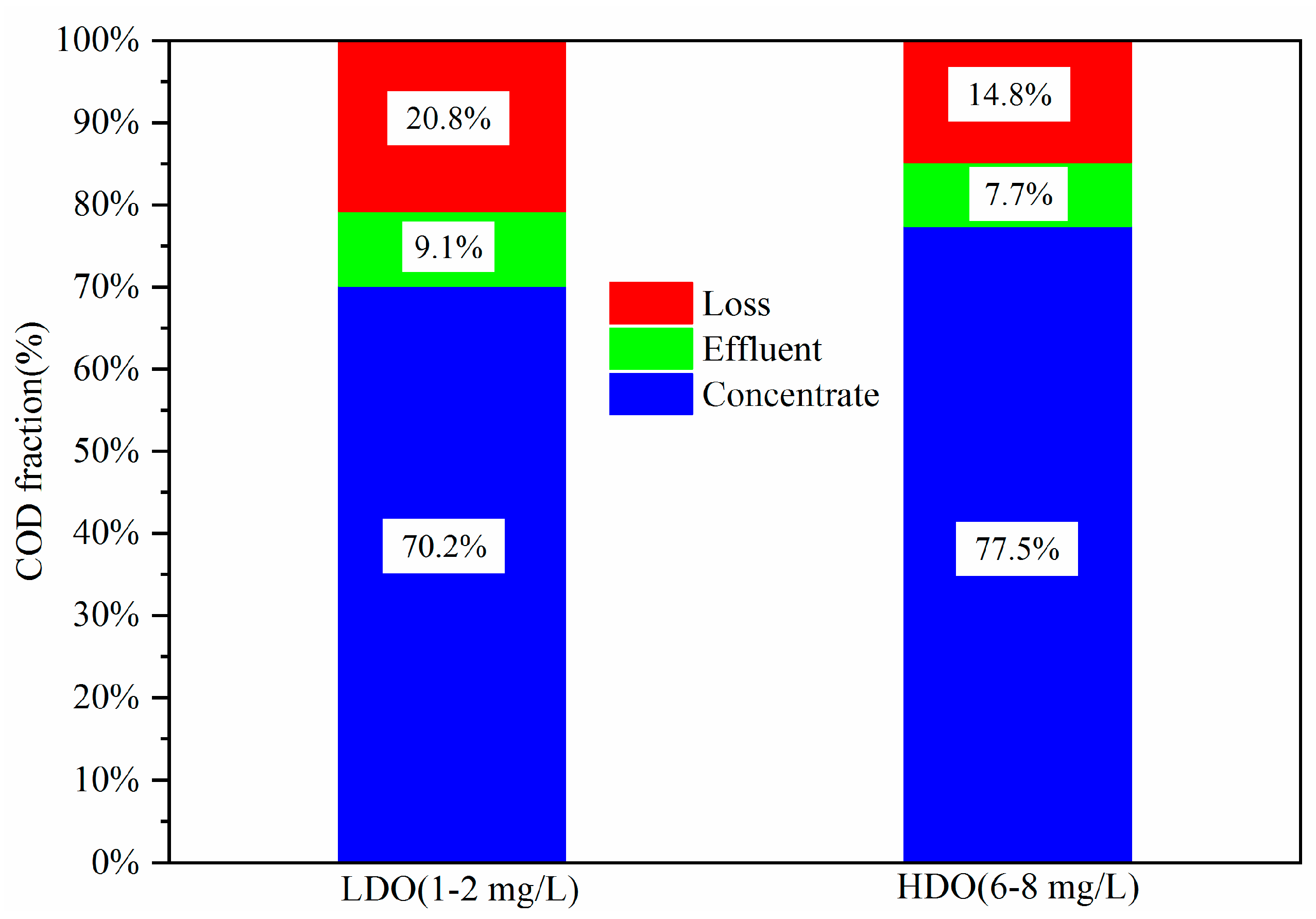
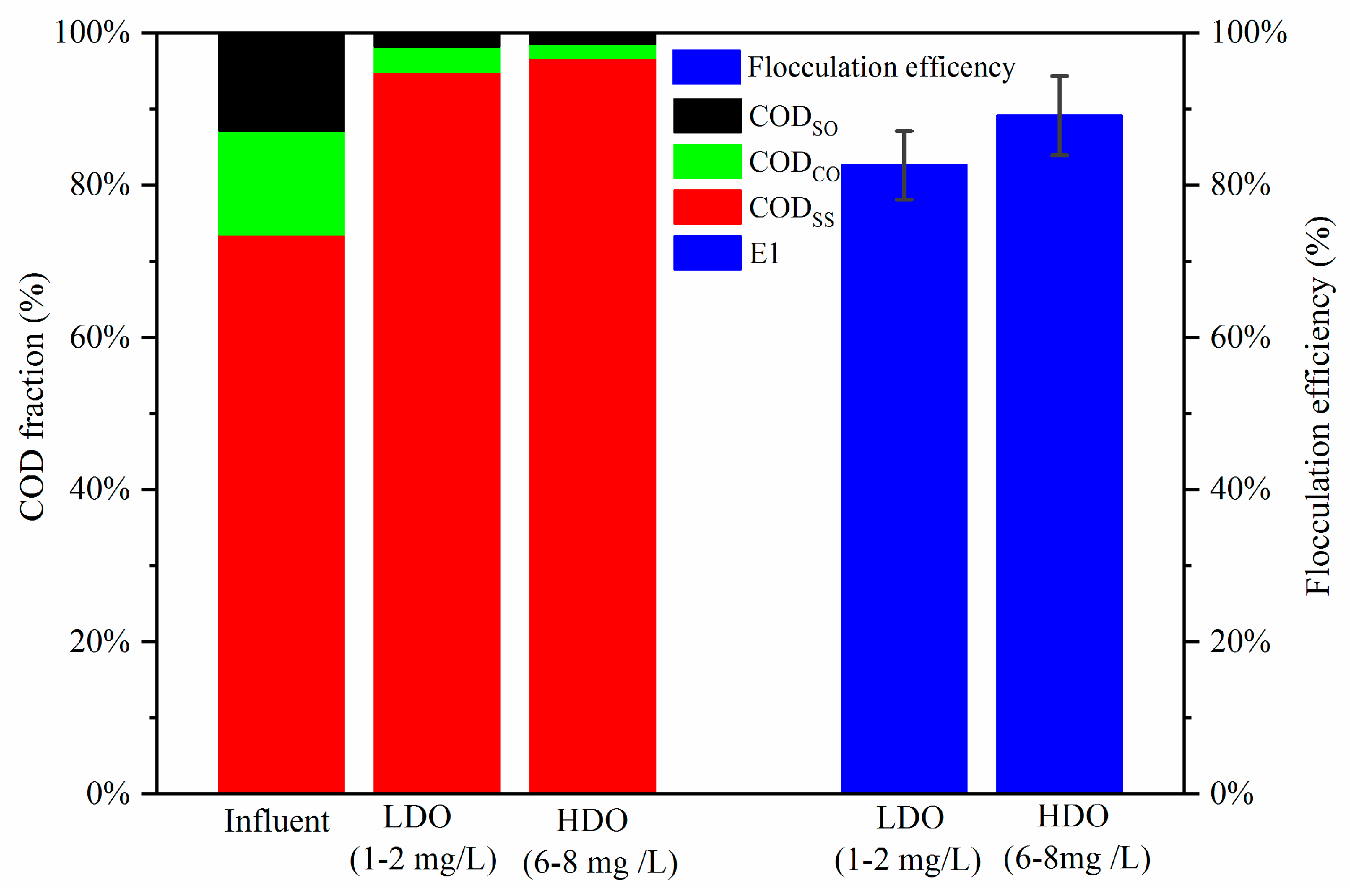
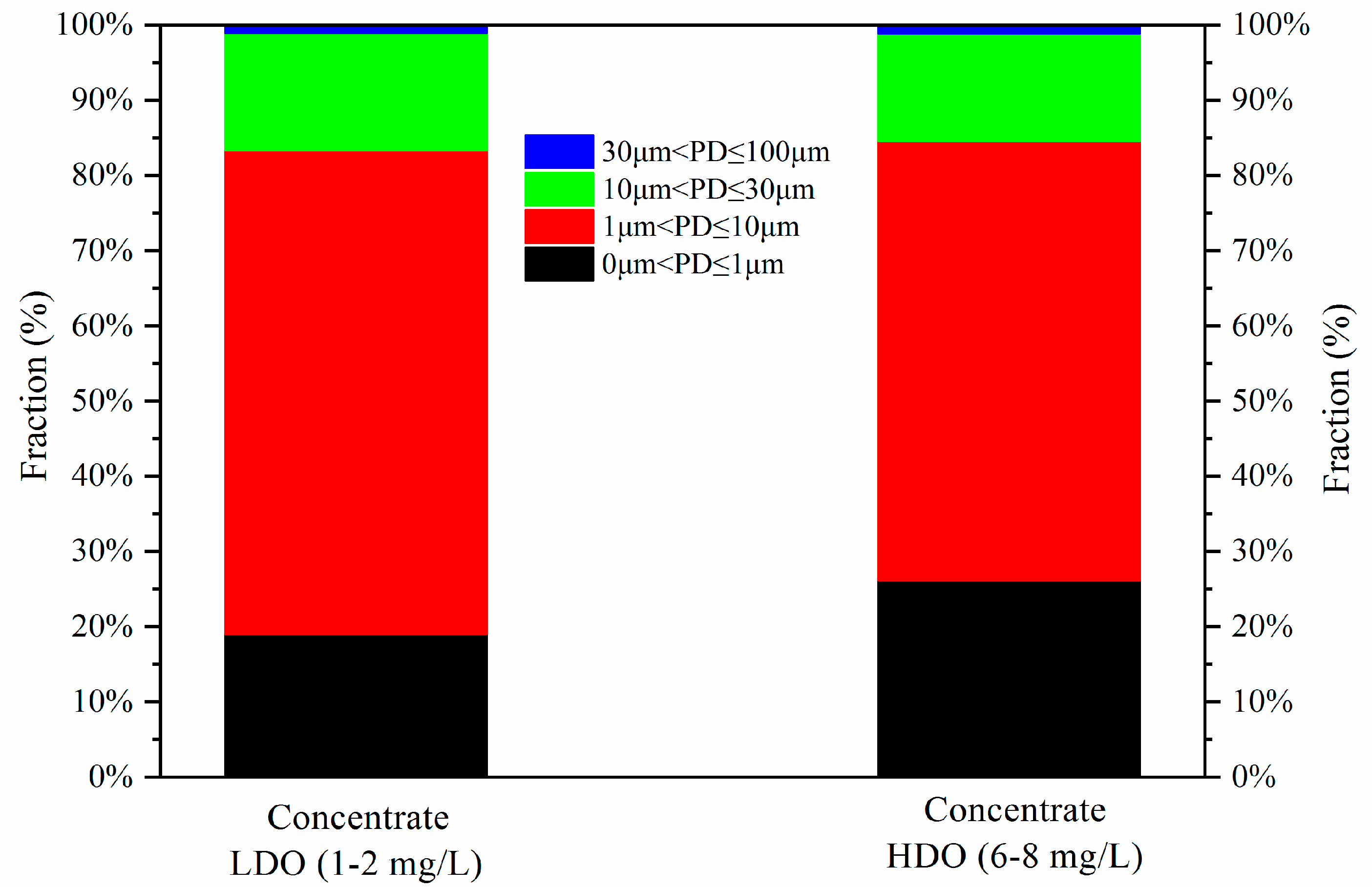

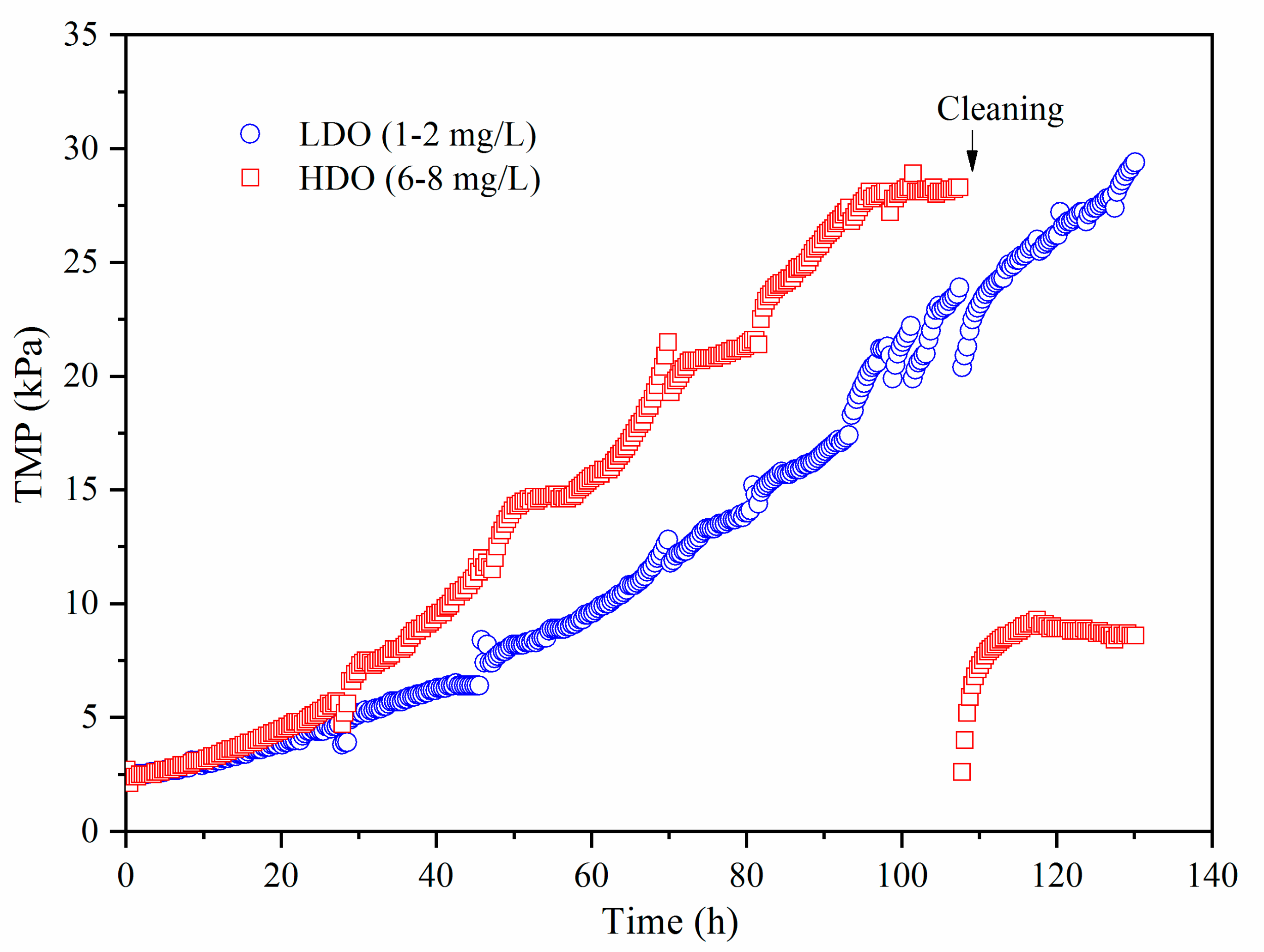
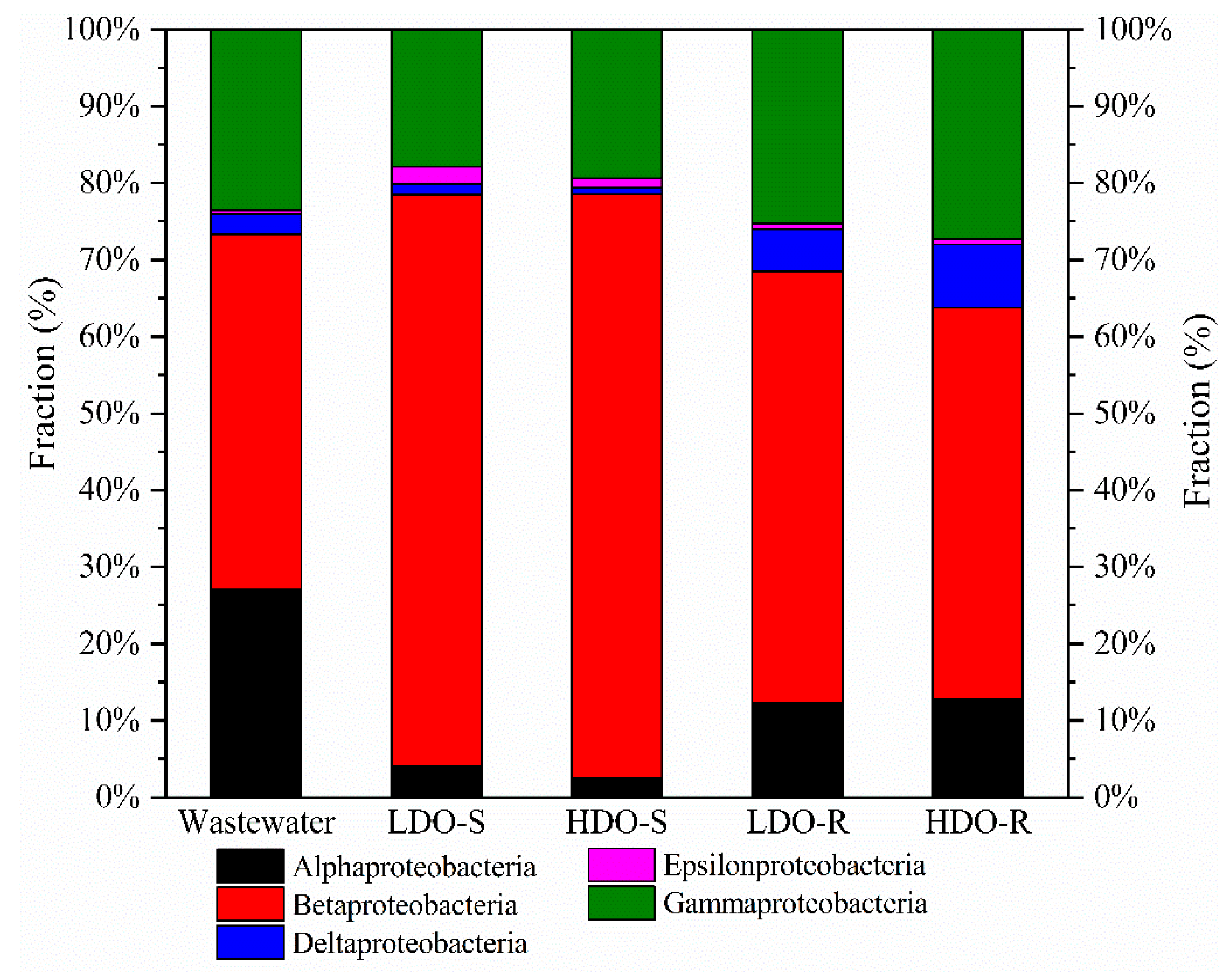
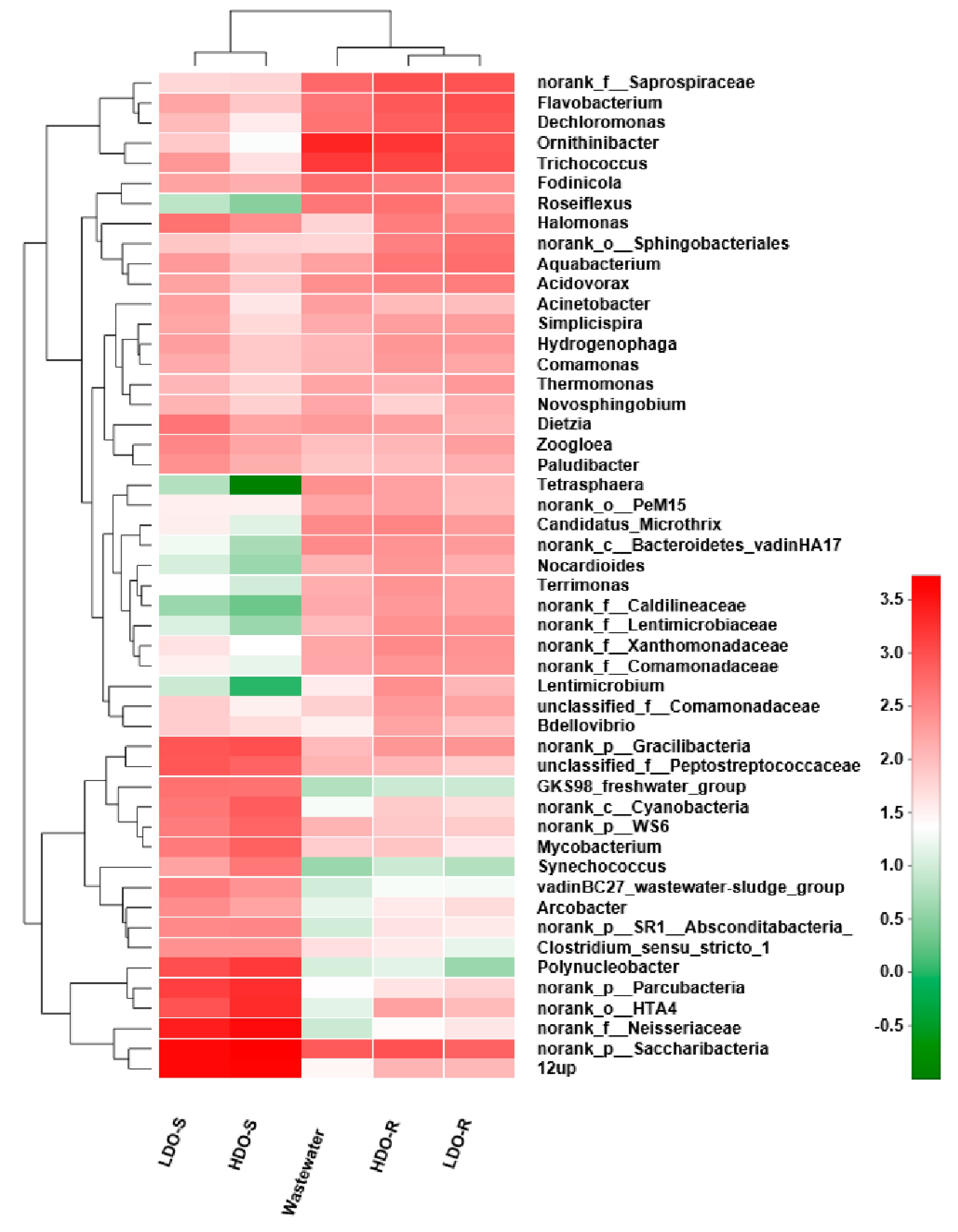
| Chemical Oxygen Demand (COD) | NH4+-N | TN | TP | SS |
|---|---|---|---|---|
| 351 ± 21 | 26 ± 4 | 30 ± 6 | 0.5 ± 0.08 | 500 ± 132 |
| CODss | CODCO | CODSO | CODTO | ||
|---|---|---|---|---|---|
| influent | 258 ± 21 | 48 ± 5 | 45 ± 3 | 351 ± 21 | |
| LDO (1–2 mg/L) | concentrate | 3510 ± 238 | 120 ± 13 | 69 ± 8 | 3699 ± 312 |
| effluent | 34 ± 5 | ||||
| HDO (6–8 mg/L) | concentrate | 4049 ± 335 | 75 ± 8 | 62 ± 6 | 4186 ± 336 |
| effluent | 29 ± 3 | ||||
| Supernatant Concentration (mg/L) | Sediments Concentration (mg/gTSS) | |||||||
|---|---|---|---|---|---|---|---|---|
| Ca2+ | Mg2+ | Al3+ | Fe3+ | Mg2+ | Al3+ | Ca2+ | Fe3+ | |
| LDO (1–2 mg/L) | 6.4 | 0.16 | 27.10 | 0.06 | 17.31 | 6.09 | 14.93 | 10.31 |
| HDO (6–8 mg/L) | 5.2 | 0.17 | 25.20 | 0.1 | 17.26 | 6.47 | 17.01 | 10.6 |
© 2020 by the authors. Licensee MDPI, Basel, Switzerland. This article is an open access article distributed under the terms and conditions of the Creative Commons Attribution (CC BY) license (http://creativecommons.org/licenses/by/4.0/).
Share and Cite
Wan, L.; Xiong, L.; Zhang, L.; Lu, W. High-Loaded Bioflocculation Membrane Reactor of Novel Structure for Organic Matter Recovery from Sewage: Effect of Dissolved Oxygen on Bioflocculation and Membrane Fouling. Sustainability 2020, 12, 7385. https://doi.org/10.3390/su12187385
Wan L, Xiong L, Zhang L, Lu W. High-Loaded Bioflocculation Membrane Reactor of Novel Structure for Organic Matter Recovery from Sewage: Effect of Dissolved Oxygen on Bioflocculation and Membrane Fouling. Sustainability. 2020; 12(18):7385. https://doi.org/10.3390/su12187385
Chicago/Turabian StyleWan, Liguo, Ling Xiong, Lijun Zhang, and Wenxi Lu. 2020. "High-Loaded Bioflocculation Membrane Reactor of Novel Structure for Organic Matter Recovery from Sewage: Effect of Dissolved Oxygen on Bioflocculation and Membrane Fouling" Sustainability 12, no. 18: 7385. https://doi.org/10.3390/su12187385
APA StyleWan, L., Xiong, L., Zhang, L., & Lu, W. (2020). High-Loaded Bioflocculation Membrane Reactor of Novel Structure for Organic Matter Recovery from Sewage: Effect of Dissolved Oxygen on Bioflocculation and Membrane Fouling. Sustainability, 12(18), 7385. https://doi.org/10.3390/su12187385



